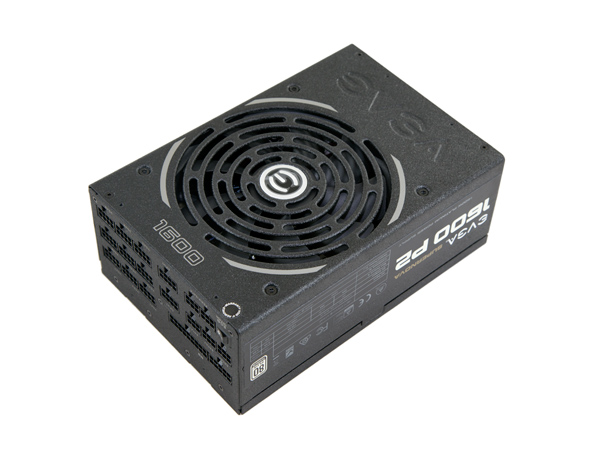EVGA SuperNOVA 1600 P2 Power Supply Review
EVGA recently introduced its flagship power supply, the SuperNOVA 1600 P2. In addition to monstrous capacity, it also features 80 PLUS Platinum efficiency, promises top performance levels and offers silent operation in semi-passive mode.
Why you can trust Tom's Hardware
Extreme Power And Silent Operation
EVGA's close collaboration with Super Flower continues to produce great results. The 1600 P2 is currently the flagship of EVGA's portfolio and surely one of the best power supplies money can buy. Its main internal competitor is the EVGA 1600 G2. Even though that unit has offers lower efficiency overall, it registers higher performance thanks to its extra-tight voltage regulation and the even lower ripple levels on all of its rails. The only PSU from a competing vendor that manages to meet and pass the 1600 P2's performance is Corsair's mighty AX1500i, which costs more. And in order to offer higher performance, that unit utilizes a lot of electronic gizmos, which have yet to prove their reliability over time.
On the other hand, EVGA looks to be super confident in the reliability of its high-end platforms, given a huge 10-year warranty. However, we can't help but be a little concerned about the 1600 P2's reliability over time, since the semi-passive (ECO) mode allows for increased temperatures before it finally engages the fan. On the other hand, Super Flower's and EVGA's engineers must have thoroughly tested this platform, or else they wouldn't have offered the aforementioned guarantee, which exceeds by three years the second-longest warranty period. On top of that, the exclusive use of high-grade Japanese capacitors, both electrolytic and polymer, ensures that this PSU will retain its good performance for a very long time. Tough conditions really shouldn't affect its reliability.
The new EVGA 1600 P2 is the ultimate PSU for anyone wanting to build a super PC with lots of highly overclocked components, especially power-hungry graphics cards. Under stock speeds and normal conditions, lower-capacity PSUs can handle the consumption of even high-end components. But when the clock rates go much higher, power delivery needs increase quickly and can easily get out of control. This means that if you plan to do some serious overclocking or you just want to be super future-proof, then you should take PSUs like the 1600 P2 into serious consideration. In this price range, the only actual competitor for the 1600 P2 is its sibling, the 1600 G2. As of this writing, their price difference is small, only $30. However, the 1600 G2 registers even higher overall performance thanks to its tight voltage regulation, lower ripple and longer hold-up time. Nonetheless, it is less efficient and, most importantly, makes much more noise since it isn't equipped with a semi-passive mode. If you don't care much about acoustics and want to save a small amount of money, then you should go with the 1600 G2. Otherwise, the Platinum-rated offering is simply a better deal.
The EVGA 1600 P2 offers a huge amount of power with excellent performance of the +12V rail with transient loads. The PSU is capable of delivering full power at 47 degrees Celsius flawlessly along with superb ripple suppression. The unit is very quiet for a 1.6 kW PSU (much quieter than the G2-1600, which doesn't feature a semi-passive mode). A nice plus in this PSU is that only Japanese capacitors are used and a great number of cables and connectors come in the box (including 14 PCIe connectors). The EVGA 1600 P2 also offers ATX-bridging plug in the bundle, long and stealth cables, and a high-quality AC power cord that’s thick enough to power the amperage with 115V. The EVGA 1600 P2 comes with a 10-year warranty and is compatible with the G2/P2 Power Supply Cable kit (individually sleeved cables), which features high-quality sleeving.
However, the EVGA 1600 P2 has very large dimensions and offers lower than 16-ms hold-up time. The ECO switch for the fan is located at an inconvenient place, there’s only a short distance among peripheral connectors and the ATX cable should be a little bit longer. Finally, the 5VSB rail should be more efficient.
Get Tom's Hardware's best news and in-depth reviews, straight to your inbox.
Current page: Extreme Power And Silent Operation
Prev Page Performance, Performance Per Dollar And Noise Ratings
Aris Mpitziopoulos is a contributing editor at Tom's Hardware, covering PSUs.
-
damric Good review, but missing the hot box testing to see if this thing regulates and suppresses ripple at 50C as advertised.Reply -
Aris_Mp All tests were conducted at high ambient temperatures which during full load were above 47C. Only the Cross-Load tests were conducted at 28-30C.Reply -
Giannis Karagiannis Very detailed review indeed. There isn't really anything that could be covered and it is not. I don't think that there are many PSU manufacturers out there that can test their products so extensively.Reply -
Aris_Mp I had the opportunity to test the 2 kW model (from Super Flower) and it is indeed superb. But it will provide 2 kW only with 230 VAC input since a normal socket can deliver only up to 15 A of current.Reply -
damric Reply15234131 said:Too light for me I have the 2000w coming from Dabs when it comes to retail.
Where are you from that you need all that power? Cybertron? -
damric Reply15233469 said:All tests were conducted at high ambient temperatures which during full load were above 47C. Only the Cross-Load tests were conducted at 28-30C.
47C ambients? Must have been sweating your language, please off, or you are language, please me. -
damric Reply15234630 said:I'm going to power my Skynet build with it.
One day you need to show us a picture of everything. I've seen little snapshots here and there, but I'd like to see it all in one thread.
